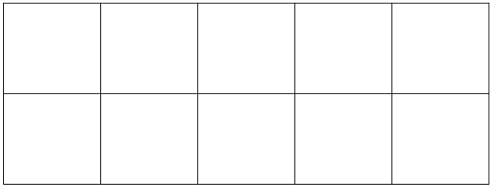Explore multiplication of two whole numbers with products from 0 to 144, and related division facts.
Multiply a one-digit whole number by a multiple of 10, up to 90, or a multiple of 100, up to 900, with procedural reliability.
Multiply two whole numbers from 0 to 12 and divide using related facts with procedural reliability.
An array arranges dots or other symbols into equal rows and columns, and can represent multiplication or division.
A 10 frame organizes numbers quickly for students. There are 5 boxes on the top, and 5 rows on the bottom, so groups of 5 and 10 are instantly recognizable. 5 and 10 are "benchmark numbers." Benchmark numbers like 5 and 10 are very easy to multiply, and therefore help with fact derivation.

When a student looks at this 10 frame, they can easily see that there are 2 dots in each box, and that 5 boxes are filled in. Students easily remember their 10s facts, because they are as easy as counting by 5s.
Using a 10 frame can help students to derive their multiplication and division facts easily. When a student looks at this 10 frame, they see that all 5 boxes on the top are filled in (5 x 2). There is one more group of 2 on the next row (2 x 6). This is especially helpful with larger numbers like 8 x 6 or 8 x 7. The 10 frame helps students see that 8 x 6 is just 8 x 5 (an easy fact to remember) plus one more group of 8.
In the same way, using a 10 frame can help students derive facts by subtracting. If a student looks at this 10 frame, they can think about 2 x 10, and then subtract one group of 2. Again, this is more helpful with larger facts, like 7 x 9. A student could think of 7 x 10, and subtract one group of 7 to arrive at 63. /p>